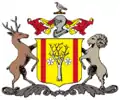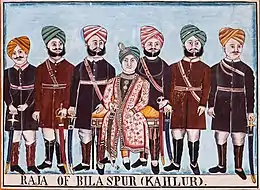Bilaspur State (princely state)
Bilaspur State or Kahlur State, sometimes Kahloor Riyasat, was a kingdom (697–1849) and later princely state (1849–1948) in the Punjab Province ruled by a separate branch of Chandravanshi Chandel dynasty. Raja Bir Chand 697–730 was the founder of the state but it was named Kahlur only after the Construction of Kahlur Fort by Raja Kahal Chand around 890–930CE and Raja Anand Chand the 44th Raja was the last ruler.
Bilaspur State Kahlur Riyasat Kahlur (कहलूर) | |||||||
|---|---|---|---|---|---|---|---|
| 697CE (approx)–1948 | |||||||
 Flag
 Coat of arms
| |||||||
 Princely States of the Shimla Hills, Bilaspur in the south straddling the Sutlej (1911) | |||||||
| Status | Princely state of Hills. | ||||||
| Capital | Bilaspur, Sunhani[1] | ||||||
| Government | Monarchy | ||||||
| History | |||||||
• Established | 697CE (approx) | ||||||
• Disestablished | 1948 | ||||||
| |||||||
| Today part of | Himachal Pradesh, India | ||||||

.jpg.webp)
The state was earlier known as Kahlur Riyasat and was later renamed Bilaspur.[2] It covered an area of 1,173 km2 (453 sq mi), on the name of River Bias (from Biaspur later became Bilaspur) and had a population of 100,994 according to the 1931 Census of India. The last ruler of Bilaspur State acceded to the Indian Union on 12 October 1948.
Bilaspur State remained Bilaspur Province in independent India until 1950 when the province was briefly renamed "Bilaspur State" before it was merged with Himachal Pradesh state as a district in 1954.[3]
In the pre-partitioned Punjab, the Raja of Kahlur (Bilaspur) elevated the Kolis to the status of Kshatriya and he wanted them to serve in his army and Raja did so.[4]
History
According to local oral tradition and records during the reign of Raja Harihar Chand, a new state was founded around 697 CE by his son First Ruler Raja Bir Chand. After Raja Kahal Chand had built Kahlur Fort the state was named Kahlur (probably from Kahal-pur) and the ruling Chandel Dynasty of Kahlur was also Known as Kahluria. Initially the capital of the state was at a place named Jandbari — now in Hoshiarpur district — and then it was transferred to Kahlur Fort, but was later moved permanently to present town Bilaspur[2] by Dip Chand, the 32nd Raja of Kahlur (reigned 1663–1665)
Raja Bhim Chand who succeeded Raja Deep Chand fought Battle of Nadaun against Mughals and came out victorious. Mughals under Alif Khan were supported by Raja of Kangra and Raja Dayal of Bijarwal[5] When Raja Bhim Chand abdicated in 1692 to lead a life of sanyasi the state was at previously unknown heights. The reign of Bhim Chand's son Ajmer Chand was of conquest as well. By the end of his forty years reign the number of states paying tribute was considerable: Baghal State, Baghat, Keonthal, Beja, Mangal, Bhajji, Mahlog, Dhami, Kuthar, Kotkhai, Kunihar, Balsan, and Nehra among others. All continued to pay tribute until Mahan Chand reign 1778 but by 1790 only Mangal State continued to acknowledge Bilaspur'so suzerainty.[6] Since the 18th-century the rulers of Bilaspur State patronised artists of the Kangra painting style.[7]
Bilaspur State came under British protection in 1815[8] under Raja Mahan Chand and became one of the Simla Hill States. Raja Anand Chand was the last ruler of the princely state and Pandit Sant Ram was the last Home Minister. As Bilaspur acceded to India on 28 October 1948, Bilaspur retained an independent identity as a separate province and as a part-C State of India. The Raja was appointed commissioner of the State. In following years after Raja resigned his deputy Chhabra, who was appointed by govt of India, helped run the temporary govt of Bilaspur while the territory of the princely state was politically integrated into the Indian Union.
From 26 January 1950 Bilaspur was administered by the Government of India as a separate C-Class state named Bilaspur State which in 1954 was incorporated into the State of Himachal Pradesh as a province.[3]
The Family
Chandel in Bilaspur belong to different branches of the ruling family. These families are numerous, and all enjoyed jagir pensions from state amounting in aggregate to Rs. 40,000 a year in 1933. The chief names are:
- Ajmerchandia
- Kaliyanchandia
- Tarachandia
- Sultanchandia
Rajas
- Bir Chand, founder; (r. 697–730)
- Udhran Chand
- Jaskarn Chand
- Madanbrahm Chand
- Ahl Chand
- Kahal Chand, 6th Raja;(r. 890–930)
- Slar Chand
- Men Chand
- Sen Chand
- Sulkhan Chand
- Kahn Chand, 11th Raja. Conquered Hindur, which he created as a separate realm for his second son.
- Ajit Chand, 12th Raja (son of Khan Chand)
- Gokul Chand
- Udai Chand, (r. 1133–1143)
- Gen Chand
- Pruthvi Chand
- Sangar Chand, (r. 1197–1220)
- Megh Chand, (r. 1220–1251)
- Dev Chand
- Ahim Chand
- Abhisand Chand, (r. 1302–1317)
- Sampurn Chand (r. 1317–1355)
- Rattan Chand (r. 1355–1406)
- Narandar Chand
- Fath Chand
- Pahar Chand
- Ram Chand
- Uttam Chand
- Gyan Chand (r. 1518–1555)
- Bikram Chand (r. 1555–1593)
- Sultan Chand (r. 1593–1600)
- Kalyan Chand (r. 1600–1636)
- Tara Chand (r. 1636–1653)
- Dip Chand (r. 1653–1665)
- Bhim Chand (Kahlur) (r. 1665–1692)
- Ajmer Chand (r. 1692–1728)
- Devi Chand (r. 1738–1778)
- Mahan Chand (r. 1778–1824)
- Kharak Chand (r. 1824 – March 1839)
- Jagat Chand (r. March 1839 – 1850)
- Hira Chand (r. March 1850 – January 1883)
- Amar Chand (r. January 1883 – January 1889)
- Bijai Chand (r. 3 February 1889 – 18 February 1927)
- Anand Chand (r. 18 February 1927 – 12 October 1983)
Currency
No coins from Bilaspur State have been found, and the state may have simply been too small and remote, with little demand for currency, to mint its own. There was little long-distance trade that required currency. Any coins that did circulate in the area were probably originally from elsewhere, such as the Delhi Sultanate. After the British gained influence in the region in the mid-1800s, the British system based on the rupee predominated. For everyday transactions, though, barter was the main way that most people exchanged goods and services.[9]: 37, 222
References
- http://www.censusindia.gov.in/2011census/dchb/0208_PART_B_DCHB_BILASPUR.pdf page 11
- States before 1947 A-J
- Social, cultural, and economic history of Himachal Pradesh By Manjit Singh Ahluwalia
- Sadasivan, S. N. (2000). A Social History of India. New Delhi, India, Asia: APH Publishing. p. 244. ISBN 978-81-7648-170-0.
{{cite book}}: CS1 maint: date and year (link) - Singh, Kartar (1967). Guru Gobind Singh and the Mughals. Chandigarh: Guru Gobind Singh Foundation. p. 55. OCLC 49259.
- Mark Brentnall (2005). The Princely and Noble Families of the Former Indian Empire: Himachal Pradesh. Indus. p. 52. ISBN 9788173871634.
- Hindu Hill Kingdoms Archived 30 March 2010 at the Wayback Machine V&A Museum.
- Chisholm, Hugh, ed. (1911). . Encyclopædia Britannica. Vol. 15 (11th ed.). Cambridge University Press. p. 634.
- Mamgain, M.D. (1975). Himachal Pradesh District Gazetteers: Bilaspur. Retrieved 8 April 2023.
Further reading
- Hutchinson, J. & J. PH Vogel (1933). History of the Panjab Hill States, Vol. II. 1st edition: Govt. Printing, Pujab, Lahore, 1933. Reprint 2000. Department of Language and Culture, Himachal Pradesh. Chapter XIII Bilaspur State, pp. 494–518.
 Media related to Bilaspur State at Wikimedia Commons
Media related to Bilaspur State at Wikimedia Commons